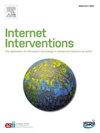Effects of digital interventions on neuroplasticity and brain function of individuals with developmental disabilities: A systematic review
IF 4.1
2区 医学
Q1 HEALTH CARE SCIENCES & SERVICES
Internet Interventions-The Application of Information Technology in Mental and Behavioural Health
Pub Date : 2025-07-02
DOI:10.1016/j.invent.2025.100850
引用次数: 0
Abstract
Developmental disabilities (DDs) impact individuals' cognitive, psychological, and motor functions, and result in specific neural differences. Interventions to enhance neuroplasticity are important for this population. This review examined relevant existing studies to understand the effects of digital interventions on neuroplasticity and neural functions of individuals with DDs. A systematic review was conducted on PubMed, PsycINFO, CINAHL, and Scopus databases. Studies that focused on digital interventions to enhance neuroplasticity of individuals with DDs and used neuroimaging methods to evaluate effectiveness were included. The results of the current review were synthesized based on Roy's adaptation model. Of 3433 retrieved studies, 37 were included. The included studies used cognitive training, neuromodulation, and social cognitive training integrated with digital devices such as a computer, mobile app, or virtual reality. Neuroimaging results after digital interventions demonstrated changes in brain wave patterns and increased activation in certain regions. Behavioral assessments exhibited significant improvements including attention- deficit/hyperactivity disorder symptoms, attention, emotional recognition, and social skills. Digital interventions may enhance neural functions and neuroplasticity in individuals with DDs. Further studies with diverse methodologies and a broader spectrum of DDs are essential to fully understand the potential of digital interventions in neurodevelopmental challenges among the population.

数字干预对发育障碍个体神经可塑性和脑功能的影响:系统综述
发育障碍影响个体的认知、心理和运动功能,并导致特定的神经差异。增强神经可塑性的干预措施对这一人群很重要。本文回顾了现有的相关研究,以了解数字干预对dd患者神经可塑性和神经功能的影响。对PubMed、PsycINFO、CINAHL和Scopus数据库进行系统评价。研究集中于数字干预以增强ddds患者的神经可塑性,并使用神经影像学方法评估有效性。本综述的结果基于Roy的适应模型进行综合。在检索到的3433项研究中,纳入了37项。纳入的研究将认知训练、神经调节和社会认知训练与数字设备(如计算机、移动应用程序或虚拟现实)相结合。数字干预后的神经成像结果显示脑电波模式发生了变化,某些区域的激活增加。行为评估显示出显著的改善,包括注意缺陷/多动障碍症状、注意力、情绪识别和社交技能。数字干预可能会增强dd患者的神经功能和神经可塑性。为了充分了解数字干预在人群神经发育挑战中的潜力,使用多种方法和更广泛的dd进行进一步研究至关重要。
本文章由计算机程序翻译,如有差异,请以英文原文为准。
求助全文
约1分钟内获得全文
求助全文
来源期刊

Internet Interventions-The Application of Information Technology in Mental and Behavioural Health
Medicine-Health Informatics
CiteScore
6.50
自引率
9.30%
发文量
94
审稿时长
6 weeks
期刊介绍:
Official Journal of the European Society for Research on Internet Interventions (ESRII) and the International Society for Research on Internet Interventions (ISRII).
The aim of Internet Interventions is to publish scientific, peer-reviewed, high-impact research on Internet interventions and related areas.
Internet Interventions welcomes papers on the following subjects:
• Intervention studies targeting the promotion of mental health and featuring the Internet and/or technologies using the Internet as an underlying technology, e.g. computers, smartphone devices, tablets, sensors
• Implementation and dissemination of Internet interventions
• Integration of Internet interventions into existing systems of care
• Descriptions of development and deployment infrastructures
• Internet intervention methodology and theory papers
• Internet-based epidemiology
• Descriptions of new Internet-based technologies and experiments with clinical applications
• Economics of internet interventions (cost-effectiveness)
• Health care policy and Internet interventions
• The role of culture in Internet intervention
• Internet psychometrics
• Ethical issues pertaining to Internet interventions and measurements
• Human-computer interaction and usability research with clinical implications
• Systematic reviews and meta-analysis on Internet interventions
 求助内容:
求助内容: 应助结果提醒方式:
应助结果提醒方式:


